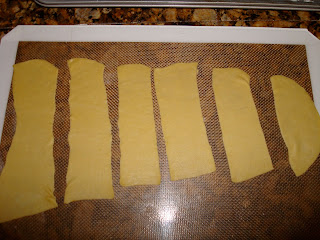Background
Years ago, in high school, we used to have to sell holiday items for the extra curricular activities in which we were involved. For me, it was choir and the catalog we brought home always included a tin of white chocolate covered pretzels. As a rule, I don't like white chocolate, but every year, I used my own saved pennies to buy myself a tin of these delectable morsels. When high school was no more and I needed to save those pennies for more necessary items, I realized I could make the pretzels myself at half the cost. This year, I resurrected the idea, transforming (so far!) an entire giant bag of tiny twists into chocolate coated deliciousness.
Ingredients
pretzels
melting chocolate (white almond bark, milk chocolate almond bark, and/or Ghirardelli 60% dark chocolate chips, the latter being my favorite)
wax paper
festive sprinkles/decorating sugar (optional)
colored melting chocolate discs (optional)
nuts (optional)
Directions
The process here is blissfully simple.
 |
| White chocolate bark beginning to melt in double boiler |
 |
| Pretzels bathing in melted white chocolate bark |
 |
| Dipped white chocolate pretzels cooling on wax paper |
Decorating tips:
Sprinkles or Decorating Sugars - these should be applied before the chocolate dries to assure they stick to your pretzel. I find the sugars show up much better on a white chocolate base, whereas more opaque sprinkles are great on any type of chocolate.
Nuts - these should be finely chopped, or even super finely chopped. You may choose to sprinkle them on as noted above, or you may also roll the pretzels in the nuts. In this case, drop them directly into a bowl of nuts when you remove them from the double boiler. Roll them in the nuts to coat and remove to wax paper so they can set up.
Chocolate Drizzling - If you choose to use a second kind of chocolate on your pretzels, I recommend drizzling in a back-and-forth motion over the pretzel. This will give the effect of streaks. You may choose to use colored melting chocolate (such as green or red for Christmas, blue for Chanukah, or team colors if you're watching the big game!) or a chocolate chip (semi-sweet or dark over white chocolate, peanut butter or butterscotch over dark chocolate). Simply fill a plastic sandwich baggie 1/3 of the way with your chips. Nestle them into one bottom corner of the bag and twist slightly so they don't spill out. Place bag in microwave and melt in 10 second intervals, until the chocolate is melted. Remove from microwave carefully, chocolate will be hot, and squeeze chocolate back into the corner of the bag. Twist strongly above the chocolate to prevent it escaping out the top of the baggie. With a pair of scissors, cut a small piece off the corer of the bag where the chocolate sits. If the chocolate string coming out is too thin, you may cut a slightly larger hole in the bag. Remember, you can always make that hole bigger, but cannot make it smaller, so it's best to start tiny. Hold bag over batch of pretzels and squeeze a ribbon of chocolate over the pretzels in a back and forth motion. Again, let them sit to dry, trying not to eat them all as they do :)


















